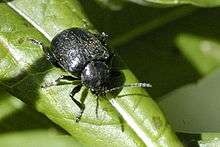Bromius (beetle)
Bromius is a genus of leaf beetles in the subfamily Eumolpinae. It contains only one species, Bromius obscurus (also called the western grape rootworm)[3]. The distribution of the species is holarctic; it can be found in North America,[4] wide parts of Europe,[5] and Asia. The species is a known pest of grape vines in Europe and western North America.[6]
| Bromius | |
|---|---|
 | |
| Scientific classification | |
| Kingdom: | Animalia |
| Phylum: | Arthropoda |
| Class: | Insecta |
| Order: | Coleoptera |
| Family: | Chrysomelidae |
| Subfamily: | Eumolpinae |
| Tribe: | Bromiini |
| Genus: | Bromius Chevrolat in Dejean, 1836 |
| Species: | B. obscurus |
| Binomial name | |
| Bromius obscurus | |
| Synonyms[1] | |
| |
Fossils of B. obscurus have been found in northeastern Russia, dating back to the late Pleistocene.[7]
Description and variations
Adults are generally colored black, covered with dull yellow-grey hairs. The elytra and tibiae are either black or reddish-brown. The basal four segments of the antennae are colored orange-red.[8]
A number of variations of the species are known to exist:[9]
- Typical form: Elytra black, covered by whitish hairs.
- var. weisei (Heyden, 1883): Elytra black, hairs yellowish, tibiae basally reddish brown.
- var. epilobii (Weise, 1882): Elytra and tibiae brown, hairs whitish.
- var. villosulus (Schrank, 1781): Elytra brown, hairs yellowish. Is superficially similar to (and has been confused with) the species Aoria rufotestacea from Korea.[9]
Historically there was disagreement over whether the obscurus and villosulus variations were in fact two separate species or not, based on morphological differences as well as other factors such as habitat and range of food plants. More recently, authors variously treat them as either variations or separate subspecies of B. obscurus.[10]
Taxonomy
The generic name Bromius Chevrolat in Dejean, 1836 is a conserved name. It was threatened by Eumolpus in the sense used by Kugelann in Illiger, 1798, which included Cryptocephalus vitis (now a synonym of Bromius obscurus). An application to conserve Bromius and other names by suppressing Eumolpus Kugelann in Illiger, 1798 (modified to Illiger, 1798) was accepted by ICZN in 2012.[11][12]
Bromius obscurus was first described as Chrysomela obscura by Carl Linnaeus in his 1758 10th edition of Systema Naturae.
Distribution
B. obscurus is a widespread Holarctic species.
In the United Kingdom, the B. obscurus was historically known from a single 10 km2 square on the Cheshire/Staffordshire border around the Bosley area.[8] However, the species has not been recorded in this area since 1992. According to a report from 2014, it was very recently found from one site in Scotland, which remains the species' only known location in the UK.[13]
Biology
A stridulatory apparatus has been observed on the upper sides of the wings of B. obscurus, the first known in representatives of the subfamily Eumolpinae. It takes a form of a darkened convex microstructure spot near the end of each wing, between the RS and Cu veins.[14]
Symbiotic bacteria are associated with symbiotic organs found in the gut of B. obscurus. In females, the bacteria are also associated with genital accessory organs. Molecular phylogenetic analysis has showed that the bacterial symbiont of B. obscurus belongs to a distinct lineage of the Gammaproteobacteria.[15]
Gallery
References
- Moseyko, A. G.; Sprecher-Uebersax, E. (2010). "Eumolpinae". In Löbl, I.; Smetana, A. (eds.). Catalogue of Palaearctic Coleoptera. Volume 6. Chrysomeloidea. Stenstrup, Denmark: Apollo Books. pp. 619–643. ISBN 978-87-88757-84-2.
- Bezděk, J. (2020). "Review of the genus-level names proposed by Johannes Gistel in Chrysomelidae (Coleoptera)". Acta Entomologica Musei Nationalis Pragae. 60 (1): 173–188. doi:10.37520/aemnp.2020.011.
- Common name
- USA distribution
- European distribution
- "Pest Alert – Western Grape Rootworm (Bromius obscurus)" (PDF). www2.gov.bc.ca. Retrieved 4 March 2019.
- Kiselev, S. V.; Nazarov, V. I. (2009). "Late Cenozoic insects of northern Eurasia". Paleontological Journal. 43 (7): 732–850. doi:10.1134/S0031030109070016.
- "Bromius obscurus (Linnaeus, 1758) | UK Beetle Recording". coleoptera.org.uk. Retrieved 4 March 2019.
- An, Seunglak; Hong, Chang‐Ki; Kim, Seulki; Lee, Seongkyun; Cho, Soowon (2014). "Aoria rufotestacea Faimaire (Coleoptera: Chrysomelidae) long been confused as Bromius obscurus (Linnaeus) in Korea". Entomological Research. 44 (2): 80–85. doi:10.1111/1748-5967.12052.
- Vig, Károly (2011). "On whose shoulders we stand – the pioneering entomological discoveries of Károly Sajó". ZooKeys (157): 159–179. doi:10.3897/zookeys.157.2044. PMC 3253647. PMID 22303108.
- Moseyko, A.G.; Sprecher-Uebersax, E.; Löbl, I. (2010). "Case 3519 Eumolpus Weber, 1801, Chrysochus Chevrolat in Dejean, 1836 and Bromius Chevrolat in Dejean, 1836 (Insecta, Coleoptera, chrysomelidae): proposed conservation of usage". The Bulletin of Zoological Nomenclature. 67 (3): 218–224. doi:10.21805/bzn.v67i3.a10.
- ICZN (2012). "Opinion 2298 (Case 3519) Eumolpus Weber, 1801, Chrysochus Chevrolat in Dejean, 1836 and Bromius Chevrolat in Dejean, 1836 (Insecta, Coleoptera, chrysomelidae): usage conserved". The Bulletin of Zoological Nomenclature. 69 (2): 147–149. doi:10.21805/bzn.v69i2.a6.
The Commission has conserved the usage of the generic names Eumolpus Weber, 1801, Chrysochus Chevrolat in Dejean, 1836 and Bromius Chevrolat in Dejean, 1836 by suppressing the name Eumolpus Illiger, 1798.
- A review of the scarce and threatened beetles of Great Britain: The leaf beetles and their allies. Chrysomelidae, Megalopodidae and Orsodacnidae. Species Status No. 19. Natural England Commissioned Report, Number 161 (Report). Natural England. 2014. Retrieved 23 December 2019.
- Medvedev, L.N.; Muravitzky, O.S. (2009). "On the presence of a stridulatory apparatus in leaf beetles of the subfamily Eumolpinae (Coleoptera, Chrysomelidae)". Entomological Review. 89 (9): 1030–1034. doi:10.1134/S0013873809090036.
- Fukumori, K.; Koga, R.; Nikoh, N.; Fukatsu, T. (2017). "Symbiotic bacteria associated with gut symbiotic organs and female genital accessory organs of the leaf beetle Bromius obscurus (Coleoptera: Chrysomelidae)". Applied Entomology and Zoology. 52 (4): 589–598. doi:10.1007/s13355-017-0513-0.